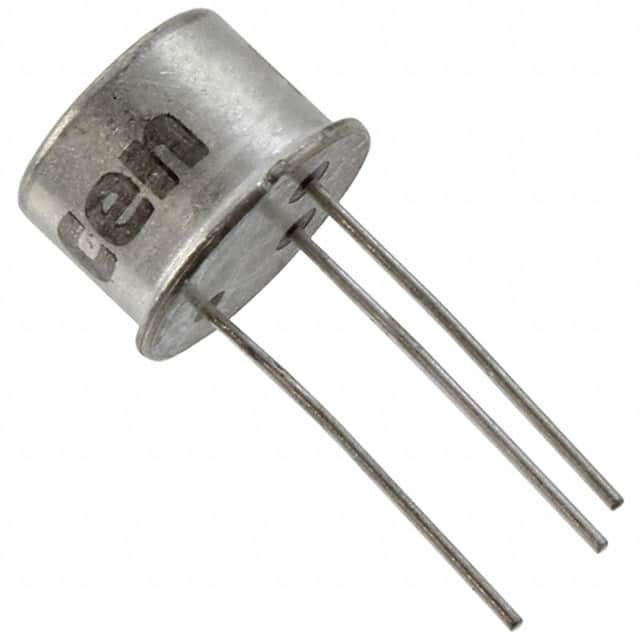2N5109 Transistor
Product Overview
The 2N5109 is a high-frequency NPN bipolar junction transistor (BJT) primarily used for RF amplifier and oscillator applications. This transistor falls under the category of electronic components and is known for its high frequency and low noise characteristics. It is commonly used in radio frequency (RF) circuits, especially in the design of amplifiers and oscillators.
Basic Information
- Category: Electronic Components
- Use: RF Amplifier and Oscillator Applications
- Characteristics: High Frequency, Low Noise
- Package: TO-39 Metal Can
- Essence: High-Frequency Amplification
- Packaging/Quantity: Typically available in packs of 10 or more
Specifications
- Maximum Power Dissipation: 0.8 W
- Collector-Base Voltage (Vcbo): 30 V
- Collector-Emitter Voltage (Vceo): 20 V
- Emitter-Base Voltage (Vebo): 3 V
- Transition Frequency (ft): 800 MHz
- Current Gain-Bandwidth Product (fT): 1 GHz
Detailed Pin Configuration
The 2N5109 transistor has three pins: 1. Collector (C): Connected to the positive supply voltage. 2. Base (B): Controls the transistor's conductivity. 3. Emitter (E): Connected to the ground.
Functional Features
- High-frequency amplification
- Low noise performance
- Suitable for RF applications
Advantages and Disadvantages
Advantages
- High transition frequency
- Low noise figure
- Reliable performance in RF circuits
Disadvantages
- Limited power dissipation capability
- Relatively low collector-emitter voltage rating
Working Principles
The 2N5109 operates based on the principles of bipolar junction transistors, where the flow of current between the collector and emitter is controlled by the base current. In RF applications, it amplifies high-frequency signals with low noise, making it suitable for use in communication systems and other RF equipment.
Detailed Application Field Plans
The 2N5109 transistor finds extensive use in various RF applications, including: - RF amplifiers - RF oscillators - Communication systems - Radar systems - Wireless transmitters
Detailed and Complete Alternative Models
Some alternative models to the 2N5109 include: - 2N3866 - 2N4427 - 2N5179 - 2N2219A
In conclusion, the 2N5109 transistor is a crucial component in RF circuit design, offering high-frequency amplification and low noise performance. Its specifications and characteristics make it well-suited for a wide range of RF applications, despite its limitations in power dissipation and collector-emitter voltage ratings.
[Word Count: 398]
Lista 10 Vanliga frågor och svar relaterade till tillämpningen av 2N5109 i tekniska lösningar
What is the 2N5109 transistor used for?
- The 2N5109 is a high-frequency NPN bipolar junction transistor commonly used in RF and microwave applications.
What are the key specifications of the 2N5109 transistor?
- The 2N5109 has a maximum collector current of 0.5A, a maximum power dissipation of 1.5W, and a transition frequency of 800MHz.
How can the 2N5109 be used in amplifier circuits?
- The 2N5109 can be used as a common-emitter or common-base amplifier in RF and microwave circuits due to its high-frequency capabilities.
Can the 2N5109 be used in oscillator circuits?
- Yes, the 2N5109 is suitable for use in oscillator circuits due to its high-frequency performance and low noise characteristics.
What are some typical applications of the 2N5109 in communication systems?
- The 2N5109 is commonly used in RF amplifiers, mixers, oscillators, and other high-frequency components in communication systems.
What are the recommended operating conditions for the 2N5109?
- The 2N5109 is typically operated at frequencies up to 800MHz and in temperatures ranging from -65°C to 200°C.
Are there any specific considerations for biasing the 2N5109 in amplifier circuits?
- Proper biasing is crucial for optimal performance, and it's important to ensure appropriate DC biasing and stability in amplifier designs using the 2N5109.
Can the 2N5109 be used in low-noise amplifier (LNA) designs?
- Yes, the 2N5109's low noise figure makes it suitable for use in LNA designs for receiving and amplifying weak signals in RF and microwave systems.
What are the typical gain characteristics of the 2N5109?
- The 2N5109 exhibits high gain at RF and microwave frequencies, making it well-suited for signal amplification in these applications.
Are there any alternative transistors that can be used as substitutes for the 2N5109?
- Some alternatives to the 2N5109 include the MRF517, MRF581, and 2SC3357, but it's important to carefully consider the specifications and application requirements when selecting substitutes.


